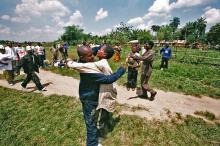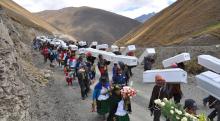Case prepared by Francesca Romana Ferrone, Joseph Gitata and Giovanni Medici Tornaquinci, LL.M. students at Roma Tre University under the supervision of Giulio Bartolini (IHL Professor), Tommaso Natoli and Alice Riccardi (Research assistants), Roma Tre University IHL Legal Clinic
A. GEORGIA: STATE STRATEGY FOR INTERNALLY DISPLACED PERSONS
This strategic document establishes the approach of the government of Georgia towards the internally displaced persons – persecuted, analyzes existing problems and determines two major goals of the state:
1. Create conditions for dignified and safe return of IDPs;
2. Support decent living conditions for the displaced population and their participation in society.
For achievement of these goals, a number of activities will be implemented, which are stipulated generally in the State Strategy and will be formulated in more detail in the Action Plan. This document determines the conceptual framework, in the form of guiding principles, on which the activities aimed at achieving these goals, shall be based.
In the process of implementing the strategy for internally displaced persons – persecuted, the state and the local authorities act in accordance with the Constitution of Georgia, the legislation of Georgia and the UN Guiding Principles on Internal Displacement (1998), within the framework of internationally recognized human rights and the norms determined by international law.
The respective Ministries and agencies, at both the State and local levels, will apply the State Strategy for solving the problems of internally displaced persons – persecuted in Georgia. The Strategy should be widely disseminated among local and international organizations, governmental and non-governmental, which are working on issues of internally displaced persons.
[...]
2. The State Strategy has two main goals:
2.1. Creation of conditions for the dignified and safe return of IDPs
2.1.1. Creation of conditions for the dignified and safe return of IDPs implies creation of conditions so that IDPs’ return to their places of permanent residence is voluntary and dignified, and in a safe environment.
[…]
2.2. Integration of the Displaced Population
2.2.1. It is necessary to create, or to eradicate the hindering factors, for IDPs to enjoy legal, political, living and socio-economic conditions like other citizens of Georgia. It should be pointed out that from the legal viewpoint, IDPs have all the rights as other citizens of Georgia; despite this, however, they are not fully integrated in the society.
[…]
B. GEORGIA: TOWARDS DURABLE SOLUTIONS FOR IDPS
With the adoption of the State Strategy for Internally Displaced Persons-Persecuted (IDPs) in 2007, the government of Georgia exhibited a policy shift. While continuing to maintain return as a settlement option for IDPs, the strategy also supports the integration of IDPs at their current residence. Before the adoption of this strategy, state policy and public discourse indicated that the only potentially durable settlement option for IDPs was to return to their places of origin. The 2007 strategy marked an increased willingness to invest to improve the situation of IDPs now and not only in the event of return.
The government showed genuine will to implement the new strategy after the August 2008 war with Russia. It acknowledged that IDPs displaced in the 1990s and 2008 would not be returning home in the near future and revised its action plan accordingly. Significant national and international resources have been mobilised for IDPs since the war, which have mainly been devoted to housing initiatives. Permanent housing is indeed one of the main outstanding displacement-related needs of IDPs, in addition to remedies for lost property; their other needs include economic opportunities and improved access to health care and education, though these may be shared by some of their non-displaced neighbours.
[…]
National response
Since the State Strategy was adopted, the government has shown increased responsibility for the protection of IDPs and has cooperated well with international organisations and donors to improve the protection of IDPs. The government has sought significant international input to the national action plan, and municipalities have sought international assistance and consulted with IDPs in drawing up their action plans. However, the Ministry for Internally Displaced Persons from the Occupied Territories, Accommodation and Refugees of Georgia has generally been left to implement the plans with limited human and financial resources and without much engagement from other Ministries. A more comprehensive approach to enabling durable solutions should include prioritisation of vulnerable groups of IDPs, increased consultation and participation of IDPs, regular monitoring of progress towards durable solutions, and greater international coordination and support.
[…]
C. MOVING TOWARDS INTEGRATION: OVERCOMING SEGREGATED EDUCATION OF IDPS
In August 2008, […] [m]ore than 138,000 people were displaced to Georgia proper and within its limits. Within a few months the majority of IDPs returned to their home areas, but an estimated 22,000 people, most of them from South Ossetia, remain displaced in 2011, including approximately 12,000 children.
[…]
In response to the 2008 displacement, the government ensured the rapid provision of education for newly displaced children without establishing a separate school system as it had for children displaced from Abkhazia in the 1990s. For instance, it refurbished a disused military base for use as a school in Phrezeti within two weeks of the first IDPs arriving at the settlement constructed there. Most children displaced in 2008 now attend existing or newly-established public schools under the authority of the MoES [Ministry of Education and Science of Georgia], while a minority attend Abkhaz schools which are connected to collective centres where recent IDPs have also been accommodated.
[…]
D. PARTIAL PROGRESS TOWARDS DURABLE SOLUTIONS FOR IDPS
The government has made good progress in implementing its 2007 strategy for internally displaced people (IDPs). Since 2008, it has made significant efforts in building and refurbishing housing, and set standards to guide the implementation process with the international community. This has improved the living conditions of many IDPs.
This housing assistance has met several challenges, however. Some IDPs received substandard new or refurbished housing and are still waiting for property titles as agreed. Timelines for housing assistance are ambitious, and measures are often taken without due planning or communication with IDPs. The majority of IDPs are yet to receive a housing solution, which includes the most vulnerable IDPs who have not been prioritised for support as well as those who have returned to their damaged homes.
Greater attention to the creation of livelihood and job opportunities is needed for IDPs in their place of refuge and return. Without this, most IDPs continue to depend on state benefits as their main source of income. The government’s action plan for IDPs includes measures for livelihoods and jobs, but this needs to be strengthened with accurate data and funding clarified.
[…]
Housing
Considerable progress has been made in addressing the housing issues of IDPs displaced in the 1990s.The government’s action plan for implementing the 2007 strategy envisages the provision of housing in three phases for all IDPs displaced in the 1990s: the renovation of living spaces in some collective centres and the transfer of ownership rights to their occupants, the construction of new apartment blocks and transfer of ownership, and financial support for families to buy or improve their own housing. The government is currently well into the first phase, which it started in February 2009, and has begun work on the second. By 2011 it had offered renovation, ownership or resettlement to over 16,000 families in collective centres, mainly in Tbilisi. They made up about 30 per cent of all collective centre residents. More than 7,000 living spaces in almost 300 collective centres had been renovated and nearly 6,500 families had had their rights of ownership registered […]. In 2011, at least 29 collective centres had set up condominium associations.
[…]
Discussion
I. Classification of the Situation and Applicable Law
1. How would you classify the situations in Georgia in the 1990s and in 2008? Did IHL apply? What additional information would you need to make such a determination? (
GCI-IV, Arts 2-
3;
P I, Art. 1;
P II, Art. 1)
2. Does the classification of the situation matter for determining whether IHL was respected in this case?
II. Internal Displacement
4. What obligations, if any, do the parties to the conflict bear vis-à-vis IDPs in the aftermath of an armed conflict?
III. Elements Contributing to Respect of IHL
5. What was the relevance of Georgia establishing a proper Ministry for dealing with IDPs (Document B)?
6. (Document C) Why was it important for the Georgian government to ensure that education for displaced children was not disrupted and established consistently with the Georgian school system?
7. In your opinion, why violations of IHL during the conflict may impede the rapid return of IDPs once hostilities have ceased? Why, and how, can better compliance with IHL during the conflict facilitate their return?






